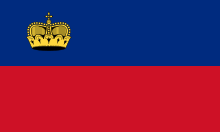History of the Jews in Liechtenstein
The Jewish community of Liechtenstein today is a population of 26 people.[1]

World War II
According to a 2005 study, about 240 Jewish refugees fled during the Nazi era, and found safety in the neutral Alpine principality during World War II. In addition, the principality allowed 144 Jews to become citizens “in return for high fees” during the Nazi era. Most of those new citizens (German: Neubürger) never lived in Liechtenstein but chose another country. The fact of being a Liechtensteiner made it easier for them to establish themselves in a Western country.
However, an unknown number were turned back. Between 1938 and 1939 at least 132 applications for entry visas were refused.[2]
Even though it was sandwiched between neutral Switzerland and Nazi-controlled Austria, Liechtenstein still had some room to manoeuvre. Liechtenstein accepted mainly rich Jews, who were expected to spend their money in the country or who created jobs by establishing companies in the principality. Like most other Western and overseas countries, Liechtenstein tightened its immigration laws in 1938. Liechtenstein’s policy can therefore be compared to that of other countries.
The family of Liechtenstein’s Prince Franz Josef II bought property and art objects taken from Jews in Austria and Czechoslovakia and rented Jewish inmates from a Nazi SS concentration camp near Vienna for forced labour on nearby royal estates, a study said.[2]